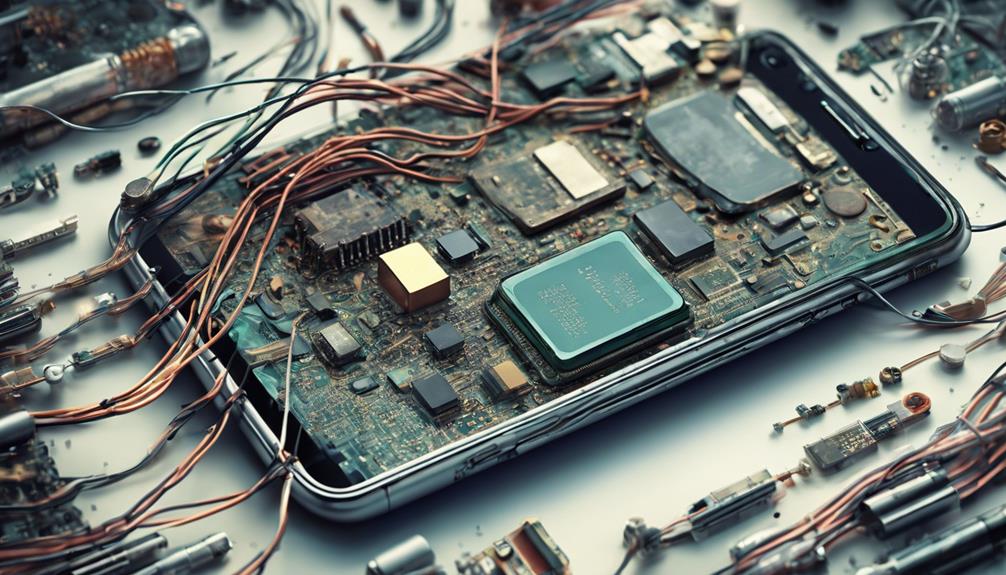Smartphones, ubiquitous in our daily lives, are intricate pieces of technology that seamlessly blend hardware and software functionalities. From receiving signals through complex cellular networks to managing multitasking capabilities with precision, these devices operate as digital marvels. But how exactly do these handheld powerhouses manage to juggle numerous tasks simultaneously while providing a seamless user experience? The inner workings of smartphones unveil a world of integrated components and processes that converge to deliver the modern functionalities we often take for granted.
Key Takeaways
- Smartphones function through advanced components like processors and wireless communication for seamless multitasking and connectivity.
- Operating systems like iOS, Android, and Windows power smartphones, offering enhanced functionality and customization options.
- Connectivity via Wi-Fi, Bluetooth, and cellular networks enables data transfer, while apps enhance communication, security, and productivity.
- Security measures like biometric authentication and encryption ensure data protection, while app permissions control access rights for enhanced security.
Evolution of Smartphone Technology
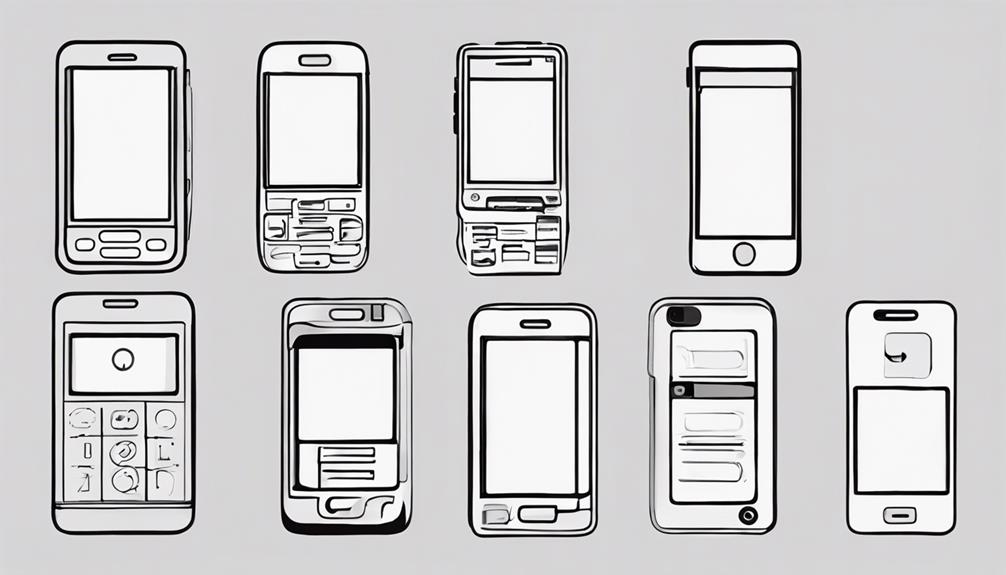
The progression of smartphone technology has transformed these devices from simple communication tools into multifunctional gadgets embedded with advanced computing capabilities. Smartphones, also known as cellular telephones or mobile phones, have evolved significantly over the years. One crucial aspect of this evolution is the integration of sophisticated Operating Systems (OS) that power these devices, enabling features like web browsing, app installations, and multitasking.
From the early days of basic keypads and limited displays, smartphones have now shifted to intuitive touchscreens with high-resolution screens, offering a more interactive user experience. Modern smartphones not only support traditional voice calls and messaging but also incorporate advanced technologies like NFC for contactless payments and infrared focusing beams for enhanced photography.
Furthermore, the rise in mobile broadband subscriptions surpassing wired broadband indicates a significant shift towards mobile network technologies, showcasing the continuous evolution and innovation in the realm of smartphone technology.
Components of a Smartphone
Within a smartphone, various intricate components intricately collaborate to enable its diverse functionalities and capabilities. Key components include circuit boards, which serve as the foundation for connecting different parts of the device and facilitating data flow. Processor chips are essential for executing tasks, managing operations, and ensuring smooth performance. NFC antenna connectors enable Near Field Communication for contactless data exchange, while infrared focusing beams assist in enhancing camera functionalities such as depth sensing and facial recognition. Wireless communication components allow smartphones to connect to cellular networks, Wi-Fi, Bluetooth, and other devices seamlessly. The integration of these components poses a design challenge, requiring a balance between performance, size, and power efficiency. As smartphones have evolved from traditional models with physical keyboards to sleek touchscreens with advanced features, the role of these components has become increasingly crucial in driving hardware operations, supporting software functions, and enhancing overall user experiences.
Operating Systems in Smartphones
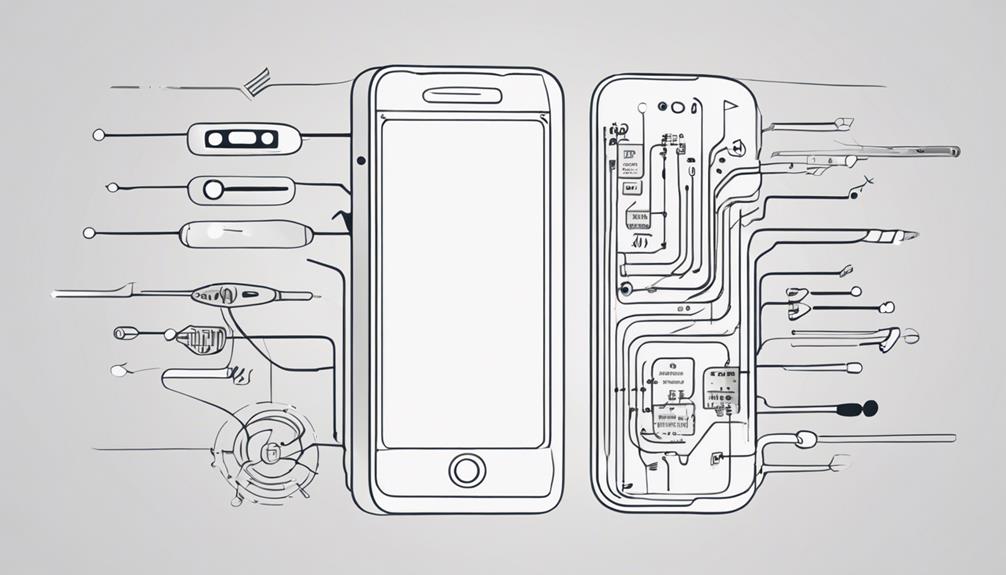
Smartphone operating systems serve as the fundamental software framework that orchestrates the seamless interaction between hardware components and user applications. These operating systems, such as iOS, Android, and Windows, are essential for managing the diverse functionalities of modern smartphones. Here are some key aspects of operating systems in smartphones:
- Diverse Options: Users can choose from various operating systems, with iOS known for its user-friendly interface, Android for its customization options, and Windows for its integration with other Microsoft products.
- Multitasking Abilities: Operating systems enable multitasking by allowing users to run multiple applications simultaneously, enhancing productivity and user experience.
- Regular Updates: Updates to smartphone operating systems are crucial as they provide improvements in performance, security enhancements, and ensure compatibility with the latest applications.
- Enhanced Functionality: These systems facilitate app downloads, data synchronization, and customization of settings, offering a seamless and personalized experience for users.
Smartphone Connectivity Explained
Smartphone connectivity encompasses the intricate web of technologies that enable wireless data transfer, ranging from traditional cellular networks to advanced 5G capabilities. Understanding the different methods of internet connection, such as Wi-Fi, is essential in grasping how smartphones access online services. Additionally, communication technologies like Bluetooth and NFC play key roles in facilitating interactions with a myriad of devices and services in the digital realm.
Wireless Data Transfer
Utilizing various wireless data transfer technologies such as Wi-Fi, Bluetooth, and cellular networks, modern smartphones establish connections and facilitate seamless communication with a wide array of devices.
- Wi-Fi: Smartphones connect to local wireless networks for high-speed internet access and data transfer.
- Bluetooth: Enables wireless connections to peripherals like headphones, speakers, and smartwatches within close proximity.
- Cellular Networks: Mobile data connectivity through 3G, 4G, and 5G networks allows internet access and calls on the go.
- Seamless Data Transfer: Smartphones use a combination of these technologies to stay connected and transfer data effortlessly across different devices and networks.
Internet Connection Methods
In establishing internet connections, smartphones employ a combination of Wi-Fi, cellular data, and Bluetooth technologies to ensure seamless connectivity and data transfer. Wi-Fi enables smartphones to connect to local networks through wireless routers, providing access to the internet. Cellular data allows smartphones to access the internet using mobile networks such as 3G, 4G, and 5G for high-speed connectivity. Bluetooth facilitates short-range wireless connections between smartphones and other devices, enabling data sharing and communication. Smartphones can switch between these connectivity methods based on availability and user settings to ensure constant internet access.
| Connectivity Methods | Description |
|---|---|
| Wi-Fi | Connects to local networks through wireless routers |
| Cellular Data | Accesses the internet via mobile networks like 3G, 4G, and 5G |
| Bluetooth | Enables short-range wireless connections for data sharing |
Communication Technologies Used
Employing a range of advanced communication technologies, smartphones seamlessly connect to cellular networks for voice and data transmission.
Communication Technologies Used:
- Smartphones utilize various cellular networks such as 2G, 3G, 4G, and 5G for internet access, calls, texts, and app usage through wireless communication.
- Bluetooth and Wi-Fi connectivity enable short-range data transfer and device-to-device communication.
- Near Field Communication (NFC) technology facilitates contactless transactions and data exchange with compatible devices.
- GPS technology integrated into smartphones allows for location tracking and navigation services, enhancing functionalities like mapping and location-based services.
How Smartphones Process Data
Smartphones efficiently process data by leveraging their advanced processors to execute instructions and perform intricate calculations, utilizing various types of memory for quick access and retrieval. Data processing in smartphones involves storing information in different types of memory such as Random Access Memory (RAM), cache memory, and hard storage. These memory components play a crucial role in ensuring swift data access and retrieval, enhancing the overall performance of the device. Additionally, smartphones may also utilize cloud storage services for secure online data storage and backup, providing users with accessibility and data security.
To illustrate the importance of various components in data processing within smartphones, the following table highlights key elements:
| Component | Function |
|---|---|
| Processors | Execute instructions and perform calculations |
| Memory | Store data for quick access and retrieval |
| Cloud Storage | Secure online data storage and backup |
| Battery Power | Essential for operation, provided by lithium-ion batteries |
Efficient power management is crucial to optimize data processing functions and extend the smartphone's battery life, ensuring seamless operation for users.
Role of Apps in Smartphone Functionality
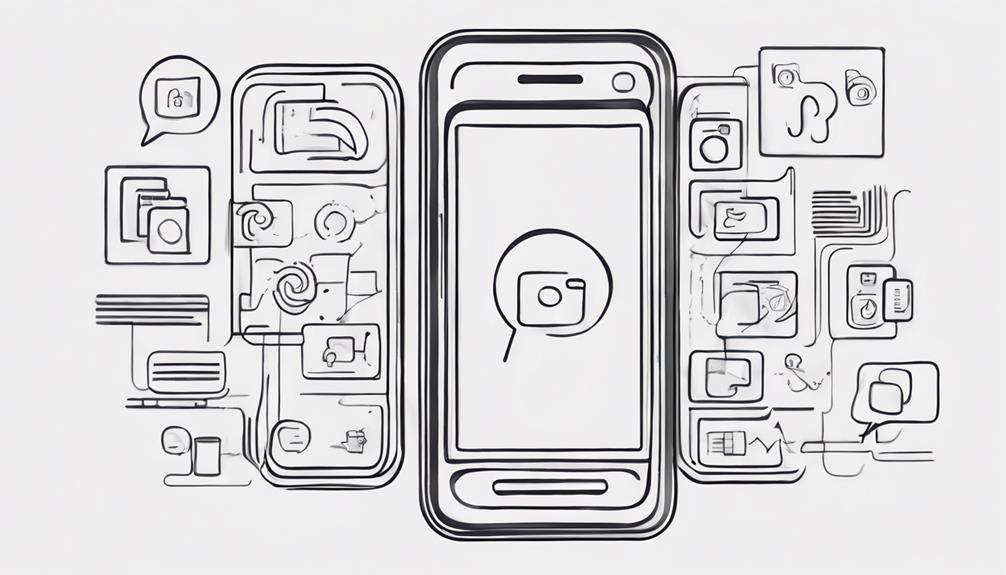
The integration of various applications plays a pivotal role in augmenting the multifaceted functionality of modern smartphones.
- Enhanced Communication: Mobile apps enable users to stay connected through messaging, social media platforms, video calls, and email services, enhancing communication on Android phones.
- Diverse Entertainment: Users can access a plethora of entertainment options like games, streaming services, music players, and virtual reality apps through app stores, transforming smartphones into entertainment hubs.
- Productivity Tools: Apps offer tools for task management, note-taking, document editing, and project collaboration, facilitating organization and productivity on the go.
- Personalization and Customization: Users can personalize their smartphones by choosing from millions of apps available on app stores, tailoring their devices to their preferences for a unique mobile experience.
Security Measures in Smartphones
Smartphones implement robust security measures to safeguard user data, including biometric authentication methods like fingerprint scanners and facial recognition. Encryption plays a pivotal role in protecting sensitive information stored on smartphones from unauthorized access. Additionally, secure app permissions, along with sandboxing techniques, help mitigate potential risks posed by malicious software, ensuring the overall security of the device.
Biometric Authentication Methods
Utilizing unique biological traits for identity verification, biometric authentication methods in smartphones offer a robust layer of security against unauthorized access. These methods, such as fingerprint recognition, facial recognition, iris scanning, and voice recognition, provide secure access to smartphones by leveraging distinct biological characteristics for verification. Fingerprint recognition, for instance, relies on the unique patterns present on an individual's fingertip, while facial recognition technology analyzes facial features to authenticate the user. Iris scanning and voice recognition are also commonly used biometric authentication methods that enhance security measures on smartphones. By incorporating biometric authentication, smartphones add an extra level of protection, significantly reducing the risk of unauthorized access and ensuring user data remains secure.
Encryption for Data Protection
Encryption serves as a critical mechanism in safeguarding sensitive data on smartphones by transforming information into secure code accessible only with the correct decryption key. Advanced Encryption Standard (AES) is a commonly used algorithm in smartphones for securing data. Secure Sockets Layer (SSL) and Transport Layer Security (TLS) protocols ensure data protection during internet transmission. In addition to encryption, smartphones employ biometric authentication methods like fingerprint scanning and facial recognition to add an extra layer of security to sensitive information. Encrypted storage options on smartphones further enhance data protection by safeguarding locally stored data from unauthorized access.
| Encryption Methods | Features |
|---|---|
| AES | Advanced Encryption |
| Biometric Authentication | Fingerprint, Facial Recognition |
| Encrypted Storage | Local Data Protection |
| SSL/TLS Protocols | Internet Data Security |
Secure App Permissions
Transitioning from data encryption to another vital aspect of smartphone security, the careful management of app permissions plays a crucial role in ensuring the protection of personal data and privacy on mobile devices. Secure app permissions in smartphones involve granting specific access rights to applications. Users can control permissions like camera, location, contacts, and microphone for each app. This helps protect personal data and privacy by limiting what apps can access. Smartphones prompt users to approve permissions when apps request access to sensitive information. Regularly reviewing and adjusting app permissions can enhance security and prevent unauthorized access to personal data.
- Granting specific access rights to applications.
- Controlling permissions like camera, location, contacts, and microphone for each app.
- Prompts for permission approval when apps request access to sensitive information.
- Regularly reviewing and adjusting app permissions to enhance security.
Impact of Smartphones on Society
Smartphones have profoundly impacted society by revolutionizing the way people communicate, access information, and interact with their surroundings. These devices have become integral to daily life, providing instant connectivity and access to a wealth of information and services on-the-go. The rise of social media platforms on smartphones has transformed how individuals interact, share experiences, and stay connected with others. Moreover, smartphones have played a crucial role in bridging digital divides by offering access to resources and opportunities for underserved communities. Industries such as healthcare, education, and commerce have been reshaped through the development of mobile applications that cater to diverse needs. The impact of smartphones on society is undeniable, influencing various aspects of personal and professional life, and driving significant changes in how people communicate, access information, and engage with the world around them.
| Social Media | Communication | Access |
|---|---|---|
| Enhanced platforms | Instant connectivity | Information on-the-go |
| Sharing experiences | Global connectivity | Services availability |
| Networking tools | Virtual interactions | Resource accessibility |
Future Trends in Smartphone Development
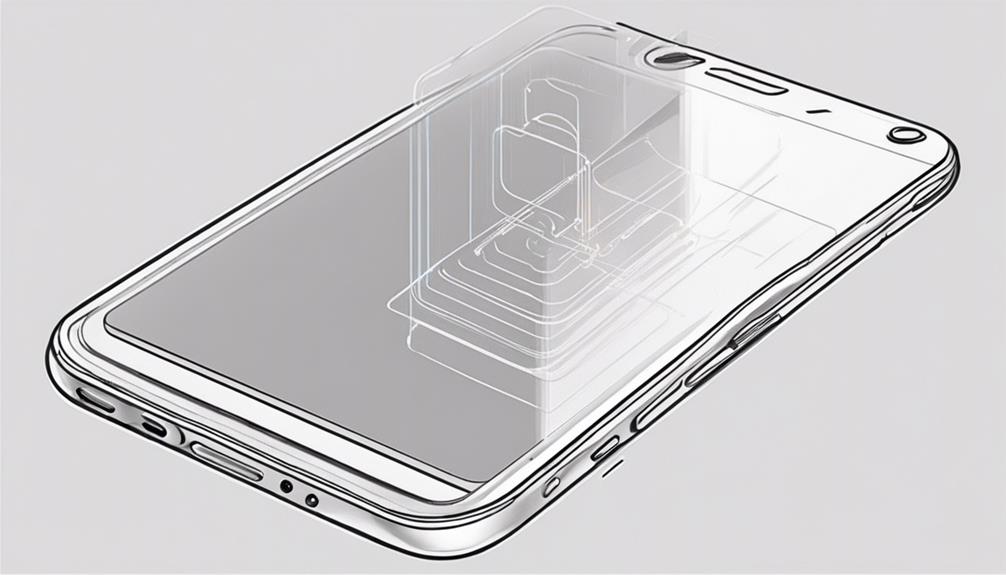
Advancements in smartphone technology continue to drive innovation and shape the future landscape of mobile devices. The following trends are set to define the future of smartphone development:
- Foldable Designs: Devices like the Samsung Galaxy Fold and Huawei Mate X are leading the way in innovative design, offering users a unique experience with foldable screens.
- 5G Technology Integration: The incorporation of 5G technology into smartphones is poised to deliver faster data speeds, lower latency, and enhanced connectivity, paving the way for next-generation mobile experiences.
- AI and Machine Learning: Continued advancements in AI and machine learning will empower smartphones to provide intelligent features such as personalized recommendations and advanced voice assistants, making interactions more intuitive and efficient.
- AR and VR Capabilities: The integration of Augmented Reality (AR) and Virtual Reality (VR) technologies into smartphones will transform various sectors like gaming, education, and entertainment by offering immersive and interactive experiences.
These developments, along with a focus on sustainable practices in smartphone manufacturing, underscore the industry's commitment to technological progress and environmental responsibility.
Frequently Asked Questions
What Is a Smartphone and How Does It Work?
A smartphone is a portable device combining cellular communication with advanced computing capabilities. Its components include hardware like processors, memory, and sensors, along with software for operating systems like iOS or Android. Touchscreen technology enables user interaction, while mobile networks provide connectivity for calls, messaging, and internet access. Battery life is crucial for sustaining device functionality. Together, these elements create a versatile tool for information access and communication in the digital age.
How Does a Mobile Phone Work Step by Step?
Mobile phones operate through a series of intricate steps involving circuit components, wireless communication technology, an operating system, touchscreen technology, and battery power. The process starts with voice conversion into electrical signals, which are then transmitted wirelessly through radio waves. Cellphone masts route these signals efficiently, dividing areas into cells to manage multiple calls simultaneously. The integration of these technologies enables the seamless functionality and communication capabilities of modern mobile phones.
How the Smart Phone Is Working?
The operation of smartphones is facilitated by various components and functionalities. Processor speed determines the device's efficiency in executing tasks, while battery life impacts its longevity between charges. Wireless connectivity allows smartphones to access networks and communicate with other devices. Touchscreen technology enables user interaction, and the operating system manages hardware and software operations. The synergy of these aspects enables smartphones to provide a seamless and versatile user experience.
How Do Modern Smartphones Work?
Modern smartphones work by integrating advanced technology components such as high-speed processors, efficient operating systems, innovative touchscreen technology, and seamless wireless connectivity. The processor speed determines the device's performance, while battery life sustains its operation. The operating system manages software functions, and touchscreen technology enables user interaction. Wireless connectivity allows access to the internet and communication networks, enabling the multifunctionality and versatility of modern smartphones.
Conclusion
In conclusion, smartphones represent a pinnacle of technological advancement, integrating various components and operating systems to enable seamless connectivity and data processing. The role of apps in enhancing smartphone functionality cannot be understated, while security measures continue to evolve to protect user data. The societal impact of smartphones is profound, shaping how individuals communicate, work, and interact with the world. As smartphone technology continues to evolve, the future holds exciting possibilities for further innovation and development.
